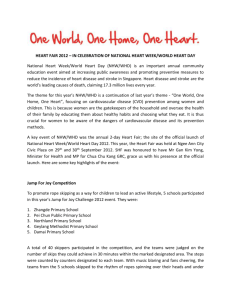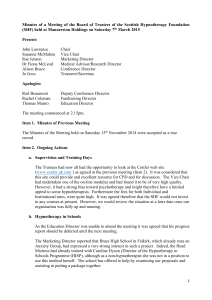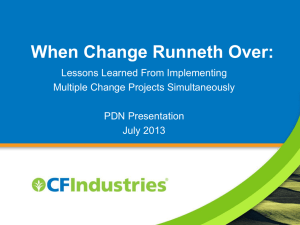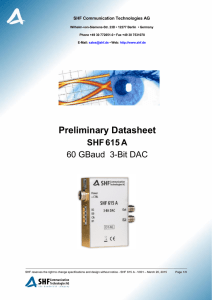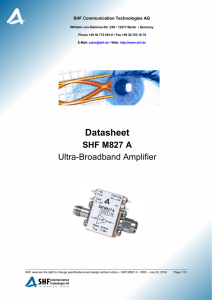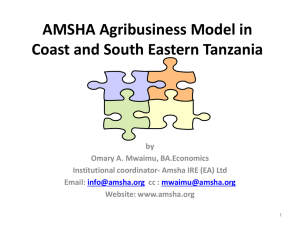here - African Smallholder Farmers Group
advertisement
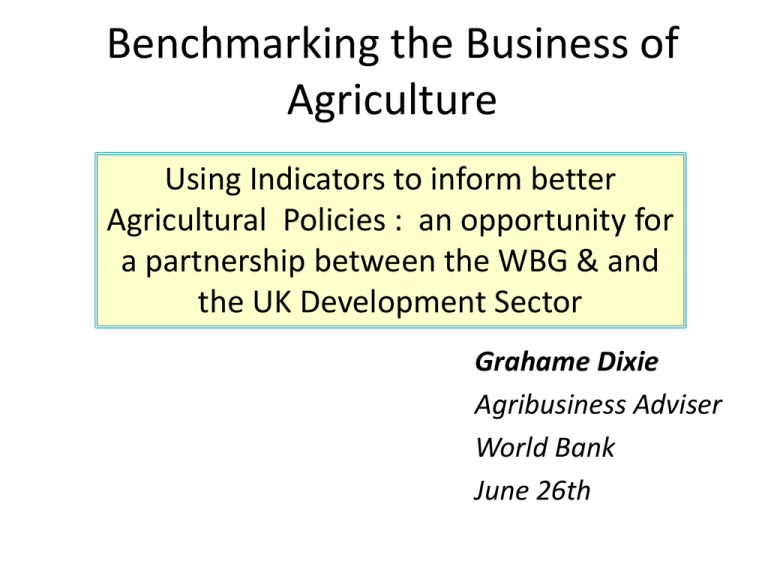
Benchmarking the Business of Agriculture Using Indicators to inform better Agricultural Policies : an opportunity for a partnership between the WBG & and the UK Development Sector Grahame Dixie Agribusiness Adviser World Bank June 26th Benchmarking the Business of Agriculture Components BBA components Deep Dives Studies Doing Business in Agriculture Agribusiness Indicators (ABI) Doing Business 2 Doing Business Project Results show strong convergence across economies since 2005 3 Benchmarking the Business of Agriculture (BBA) as part of the larger “Agricultural Transformation Index (ATI) ATI ATI ATI ATI BBA Productivity Sustainability Gender Etc.. Overview of Benchmarking the Business of Agriculture (BBA) Objective: “To inform & to leverage policy reforms which lead to a more modern agriculture sector, built primarily on the basis of commercially viable family farms” Key elements – Focusing on 8 strategic areas: inputs, finance, transport, energy, communication, markets, land & water – Will benchmark countries on short term regulatory and implementation issues, plus longer term policy, investments & important metrics – Program will operate over a purposeful sample of 80 countries, 1st year pilot : will fine tune the process & indicators in 10 countries, prior to large scale roll out What is Doing Business in Agriculture (DBA)? • • • Focuses on laws and regulations affecting the business of agriculture and their enforcement Provides actionable indicators, which are consistent over time and comparable across economies DBA indicators allow countries to benchmark their agricultural regulatory framework on the books and in practice What are the Deep Dives? • • • • • Builds on the lessons from Agribusiness Indicators (ABI) project on productivity, market access, and policy environment for agriculture Take a broader and longer term view , beyond regulatory items aim to shape future policies Identify presence or absence of key policies and the policy setting process, Generate key metrics which to enable policy makers to better understand, measure & benchmark their county’s position & tracks change over time Highlight successful examples of positive policy induced change Benchmarking Business of Agriculture - Transporting Agricultural Goods Licensing of trucking operations Restrictions on foreign transport competition Legislative framework for rural road financing …. Integrated approach Synergies Doing Business in Agriculture Access to quality rural roads Public expenditure on road maintenance % of rural population within a certain number of hours to urban market …. Deep Dives Studies new actionable indicators on rural transport 8 The agro-industry supply chain helps understand key drivers for a commercial agricultural sector in the future 1 INPUTS Seeds Fertilizers Mechanization 2 LAND PUBLIC GOODS Water Electrification Roads ENABLERS Transportation Finance ICT MARKETS Contract farming Dist. Infrastructure “Regional’ trade Project Plan Policy Priorities: Facilitating access to Market Opportunities, Needs strong, competitive, professional, & market orientated farming base, Effected by: A country’s position on the path of transition from agriculturally based to urban based economies. Country segmentation based on agriculture’s role in the national economy, provides deeper insights into the transformation of the agro-industry agriculture role as an engine of growth& poverty reduction Ag based Urbanizing Trans. 2 Trans. 1 Developed Agriculture’s role direct producer/ agribusiness relationships & creating good jobs Source WB, FAO CIA Encourage growth in agriculture & the rural non-farm economy WB Development Report 2008 Regions are at very different stages of agro-industry transformation – SSA, and to a lesser extent EAP and SA, are at the earliest stages 9 14 19 Source; BBA team calculations 12 Urban Pop Non Farming Rural Pop Farming Pop Growth in AgriIndustry Static growth in Farming Source: WB, USDA; NOTE: 2000 data Global food demand on agro-industry supply chains will be shaped by urbanizing populations & richer diets in developing regions Global Food Demand ~ +70% 2050 VS 2010 FAO Urban food demand will be the predominant challenge for future agro-industry supply chains in developing regions Source: BBA Team extrapolation of UN population and FAO per cap kcal forecasts Who will supply this demand: the need to segment Smallholder farmers as they are not a homogenous supply base, but when area farmed plus marketable surplus are overlaid, the large and medium scale small holders offer the greatest potential Marketable surplus Large SHF 80% + Medium SHF 30-50% Small SHF 17 FAO, multiple research papers 10 -15% The urban food market provides an exciting opportunity but: Without a strong & competitive supply base: Producers increasingly distanced from urban demand: Poverty will increasingly be an urban issue: The key driver is outside the control of agriculture: Key elements in the improving enabling policy environment • Capable and competitive farm base - credit for investment, access to improved inputs, greater skills, mechanisation • Market Insights - market knowledge, strengthened producers organisations, • Market access infrastructure – roads, distribution, market places • Land, water, energy availability - regulations to facilitate a secure & efficient land market, access to irrigation, electricity • Agribusiness capability - enabling business environment, access to finance, electricity, water, contractual relationship for raw material • International, regional market capability – facilitating trading across borders, harmonised quality standards, Time Line : July Sept Dec March June Preparation Field Work Analysis Expert Review Dissemination Feed back • • • • • Country selection, Refinement of indicators, additions, refocus, Local collection of information, Creation of cadre of country respondents, Capacity building program, use of indictors to inform policy & empirically based policy dialogue And if you have been . . . Thanks, for listening Area Priority Policy Outcomes Access to Markets •Ability of farms & firms to respond to domestic urban demand growth • Enablement of producer organizations to participate in domestic market supply • Maximization of regional trading opportunities Land • Ability for farm land consolidation & expansion • Certainty & enforcement of tenure security and rights Access to Finance • Lender flexibility to serve small/medium farms &firms sufficient protection for loans • Increased collateral flexibility for small farms and SME agro-enterprises t • Increased availability of institutionalized credit support services Transport • Access to quality rural and trunk road infrastructure • Efficient transport services for agricultural goods • Reduced transport prices and time-distance to markets Water • Adequacy of farmer access to irrigation • Efficient use and equitable affordability of irrigation • Adequacy of industrial water supply Electrification • Adequacy of farmer & agribusiness access to electricity • Efficient use and equitable affordability of power supply • Reliable and consistent power supply Area Priority Policy Outcomes ICT • Expansion of ICT services to farmers & agro-enterprises • Increased innovation in ICT services & expanded applications for agriculture & agribusiness Communication Seeds • Systematic ‘refreshing’ of quality commercial seed varieties • Ability to source & access best commercial seeds from all potential supply sources (including foreign suppliers) • Favorable business environment conducive for private sector participation Fertilizer • Affordable access to soil testing • Adoption of appropriate nutrient programs , macro & micronutrients • Sufficient; accessible and affordable nutrient supply for all commercial farmers Mechanization • Affordable, access to mechanization services for all farmers • Ability to sustainably achieve expected performance • Increased innovation in locally relevant mechanization ASFG Pillars: Recommended Policy Focus - 1 Topic Equitable free market agriculture Smartly supported SHF agriculture State defined agriculture Sustainable agriculture LAND • Land title, registration • Recognition of customs, international guidelines • Tenure security, esp.VGs* • Sustainable mgmt. of common property resources WATER • Infrastructure $$ • Water use policies • Governance of private water resources • ‘Land grab’ implications on water rights • VG H2O rights protection • Development of onfarm water management and water harvesting technologies INPUTS , CREDIT • Access by women farmers • Recognition of SHF voice SEEDS • Rights to access own seeds • Right to breed freely • Support to entrepreneurs • Incentives for innovative products (e.g. contracts as collateral) • Parastatal access to inputs • Access to ‘climate smart’ seeds • Incentives for wide(st) fertilizer distribution and advisory services FERTILIZERS CREDIT • ‘Smart’ SHF support (e.g. smart subsidies) • Incentives for SHF financial literary training • Incentives for SHF friendly products (e.g. agricultural development banks) * VGs – Vulnerable Groups – women, other disadvantaged • ISFM R&D • ISFM supply incentives • Smart subsidies for agro- eco technologies ASFG Pillars: Recommended Policy Focus - 2 Topic Equitable free market agriculture Smartly supported SHF agriculture State defined agriculture MARKETS • Boost local demand • Fair international trade (West’ subsidies, tariffs, production incentives) • Public extension service training on contracts, international markets participation • Preferential procurement of SHF output, especially VGs R&D • % Ag budget for R&D • Incentives for private sector R&D • SHF recognition in R&D agenda COLLECTIVE ACTION • R&D for sustainable agriculture • Up to date extension curriculum, e.g. climate smart, gender, mkt access • Public extension service coverage, incentives for private alternatives EXTENSION SERVICES • Governance of producer organizations • Protection of ‘non-legal’ cooperatives’ rights • Recognition of VGs* Sustainable agriculture • Incentives for SHF collaboration and collective action * VGs – Vulnerable Groups – women, other disadvantaged • Legal requirement and incentives to include VGs in producer organizations • Legal requirement to assess SHF impact of economic reforms Benchmarking the Business of Agriculture: integrated approach Integrated approach benchmarks of regulatory environment 0n business of agriculture Comparable across economies over time Synergies In-depth metrics of a broader range of factors Comparable across countries, but greater flexibility Deep Dives Studies Doing Business in Agriculture new actionable indicators for policy makers, public officials, and private sector investors; Leverages policy change 26 The urban food market provides an exciting opportunity but: Without a strong & competitive supply base: easily lost to imports , Agri-processing cannot establish without raw material suppliers, Producers increasingly distanced from urban demand: Market servicing becomes more important, & difficult, Transport and post harvest gain greater significance, As does quality, quality standards , food safety & changing demand , Market Knowledge is vital Poverty will increasingly be an urban issue: provision of staple foods at sensible prices ever more critical, absolute need secure & stable supplies The key driver is outside the control of agriculture: The money in the system – growth in larger economy
